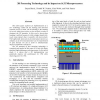Free Online Productivity Tools
i2Speak
i2Symbol
i2OCR
iTex2Img
iWeb2Print
iWeb2Shot
i2Type
iPdf2Split
iPdf2Merge
i2Bopomofo
i2Arabic
i2Style
i2Image
i2PDF
iLatex2Rtf
Sci2ools
ICCD
2004
IEEE
2004
IEEE
3D Processing Technology and Its Impact on iA32 Microprocessors
This short paper explores an implementation of a new technology called 3D die stacking and describes research activity at Intel. 3D die stacking is the bonding of two die either face-to-face or face-to-back in order to construct the 3D structure. In this work a face-to-face bonding is utilized because it yields a higher density dieto-die inter-connect than is possible with face-to-back. With sufficiently dense die-to-die interconnect devices as complex as an iA32 microprocessor can be repartitioned or split between two die in order to simultaneously improve performance and power. The 3D structure of this emerging technology is examined and applied in this paper to a real x86 deeply pipelined high performance microprocessor. In this initial study, it is shown that a 3D implementation can potentially improve the performance by 15% while improving power by 15%.
| Added | 16 Mar 2010 |
| Updated | 16 Mar 2010 |
| Type | Conference |
| Year | 2004 |
| Where | ICCD |
| Authors | Bryan Black, Donald Nelson, Clair Webb, Nick Samra |
Comments (0)

